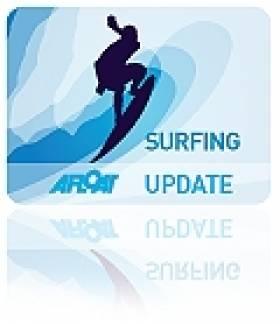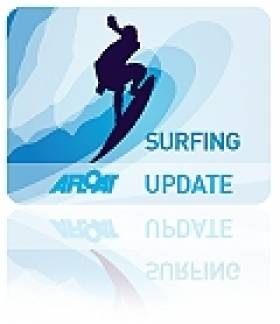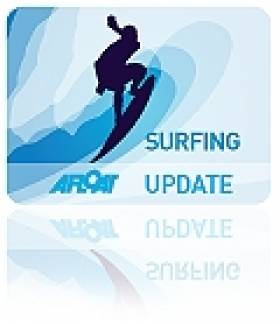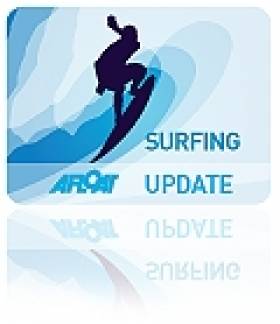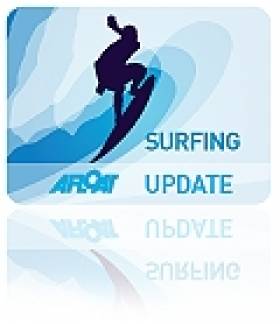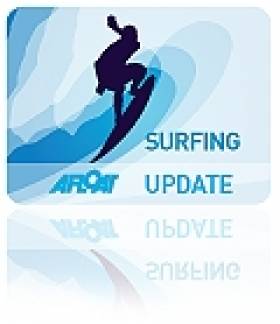Displaying items by tag: Surfing
Surfers In Ireland, Portugal Prepare For Giant Swells
#Surfing - Surfers across Europe are keeping a close eye on the weather forecast as two large swells are expected to reach the coasts of Ireland and Portugal in the coming days.
SurferToday reports that 100-foot waves could be on the cards for Mullaghmore in Co Sligo, making tomorrow 31 October a happy Halloween for any big wave riders in the region.
Meanwhile, Nazaré in Portugal - site of a reported record-breaking wave earlier this year - is the place to be for the surfing pros from 3-4 November next week.
Scotland and northern Spain will also experience some bigger-than-usual swells as the Atlantic waters rage in our direction.
Irish Surfers Celebrate Big Title Wins At Home And Abroad
#Surfing - Irish junior champion surfer Iarom Madden has clinched the men's title at the British University Championships, as the Donegal Democrat reports.
Bundoran native Madden - who studies at University College London - used his skills honed on some of the world's finest waves to fend off competition from some of the UK's top young guns to take first place in what was his first appearance at the contest in Newquay, Cornwall last weekend.
And he follows in the wake of fellow Bundoran surfer Shauna Ward, who took the women's title in 2007.
In other surfing news, Coleraine's Martin TK Kelly celebrates his 11th national title after being declared Irish National Bodyboard Champion for 2013.
According to the Coleraine Times, the win makes 35-year-old Kelly the most decorated Irish surfer of all time.
But he's not one to rest on his laurels, stating that his goal for 2014 "is not to defend my Irish Title but to rejoin the European Tour Of Bodyboard where in the past I have finished 21st."
Riding The Cold-Water Waves In Dunfanaghy
#Surfing - Travel writer Pól Ó Conghaile has posted his recollections of surfing the wintery waters of Dunfanaghy in North Donegal.
With "waves you’d be hard pressed to find in Australia", the region proved to Ó Conghaile why surfing in Ireland is such a draw for world-class pros and land-lubber novices alike.
"Sheltered or exposed, facing every which way, throwing up all kinds of waves – sure, the water is cold, but with the right gear you can break out the board no matter what," he writes.
And there's more on the story at Pól Ó Conghaile's website HERE.
Easkey Britton Talks Surfing Across Barriers In Iran
#Surfing - Surfing has the power to bring people together across cultural and gender barriers, according to Easkey Britton, whose talk at the recent TEDxDublin event has now been posted online.
"It's as if the salt water literally dissolves those barriers and fears we carry with us when we're on land," she says of taking to the waves and immersing in the power of nature, "and we're no longer separate but a part of it all."
Surfing also helps people to get out of their comfort zone - something Britton knows all about after becoming the first woman to surf the waters of Iran last year.
Travelling to the remote province of Baluchestan in south-eastern Iran initially in search of new waves to ride, Britton - of the famed Donegal surfing dynasty - explains how her mission quickly changed to one of connecting with people through surfing.
She recently returned to the region - three years after her first visit with a documentary crew in tow - to find she's sparked something of a quiet revolution in the area, which now boasts a surfing programme to get both men and women out on the waves.
See footage from Easkey Britton's original trip to Iran below:
Irish-Australian Surfer Edges Closer To Third World Title
#Surfing - Irish-Australian surfing star Mick Fanning built up a 6,000-point lead on his closest rival, surf legend Kelly Slater, to win the Quiksilver Pro France title yesterday (4 October).
And as the Sydney Morning Herald reports, the win edges Fanning ever closer to a third reign as world surfing champion.
The Aussie of Irish parentage clinched the title in one-metre waves at the backup venue of Le Penon on the Bay of Biscay near the Spanish border.
And the 32-year-old wave whiz claims he "never really got into rhythm" until the morning of the final day, which makes his performance all the more remarkable.
The Sydney Morning Herald has much more on the story HERE.
Last year Afloat.ie reported how Fanning and his teammates captured pioneering Matrix-style 3D footage of their surfing using GoPro HD cameras. See video of their 'Mirage Moments' below:
Surfing's Wave Of Popularity Is Good For Tourism
#Surfing - Herald.ie reports on a new drive by Irish tourism chiefs to attract surfers to our shores.
The Discover Ireland campaign has been launched in time for the popular winter surfing season in Ireland.
Despite the cold temperatures, winter is when our waves pick up the most and the pros flock to hotspots like Mullaghmore in Sligo, listed as one of the world's best.
But there's great surfing to be had all around Ireland's coast, from Donegal to West Cork, Waterford and even Wicklow.
And the campaign also hopes to reach Irish people who've never picked up a surfboard before.
Mullaghmore Makes Another List of World's Best Surf Spots
#Surfing - Mullaghmore Head in Co Sligo keeps making an impression - as the Irish Independent reports it's been named by travel guide Lonely Planet as one of the top surfing spots in the world.
The big wave mecca has been named as one of the 'Best Spots to Catch a Big Wave' in a new book of top ten lists, 1000 Ultimate Adventures.
Only last month, Mullaghmore made the list of USA Today's 'World's Most Surprising Surf Spots' - although it's no surprise to the big wave pros who've been hightailing it to the Sligo headland for years to ride the Altantic Ocean monsters.
Also featured in the adventure tourism guide as one of the best coast-to-coast walking missions is the 387-mile trek across the island of Ireland, which takes in the impressive Carrick-a-rede rope bridge in Co Antrim.
Surfing Is Powerful Therapy For Autistic Children
#Surfing - The therapeutic power of the waves is being used by an Irish network of surfing camps to help children with autism connect with their families and each other.
Afloat.ie previously reported on the Surf2heal programme in Tramore - which pairs autistic children with volunteers to help them have fun with the surfing experience - two years ago, when it was already going from strength to strength.
Now this month, Claire O'Sullivan writes in the Irish Examiner about the latest group of kids to enjoy the surf at Inchydoney in West Cork, one of a network of beaches that includes Garrettstown near Kinsale, Banna in Kerry, Fanore in Clare and Strandhill in Sligo.
And the experience has had some dramatic effects on the children, as one mother testifies.
“In the past few weeks, I’ve seen a kid, whose mum doesn’t like the water, race out of the water to hug her mum before running back in," says Nollaig Hayes, mum of a 10-year-old autistic boy. "It was just this big spontaneous hug from a little girl who had never spontaneously shown affection like that before."
The Irish Examiner has more on the story HERE.
Mullaghmore Head Makes List Of 'Surprising' Surf Spots
#Surfing - Mullaghmore Head in Co Sligo has made the list of USA Today's 'World's Most Surprising Surf Spots' alongside such destinations as Dubai, India, Iceland and the River Severn.
"The countryside isn't all that's green in Ireland," the paper writes, describing how "enormous emerald waves pound Mullaghmore Head during the winter, making this treacherous Atlantic break on Ireland's west coast a favourite for surfing daredevils."
Whether or not Mullaghmore's surfing credentials are so surprising is debatable, however, especially since the monster swells are now a feature of the Billabong XXL Big Wave Awards.
USA Today has more on the story HERE.
Wexford Gets On The Surfing Map With First Surf School
#Surfing - Wexford now has its first ever dedicated surf school - thanks to two enterprising brothers.
The Wexford People reports on The Surf Shack in Curracloe, established by Chad and Jack-Tim Murray in an effort to put the Sunny South East on the Irish surfing map.
"Everybody knows that there are good waves on the West Coast," says Jack-Tim, referring to popular surf spots like Lahinch, Mullaghmore and Bundoran, "but most people don't even know that surfing exists on Ireland's east coast, let alone in Wexford."
The brothers aim to entice beginners to the sport, highlighting the smaller surf and safe swimming at Curracloe beach as the perfect environment for novices to ride the waves.
The Wexford People has more on the story HERE.


























